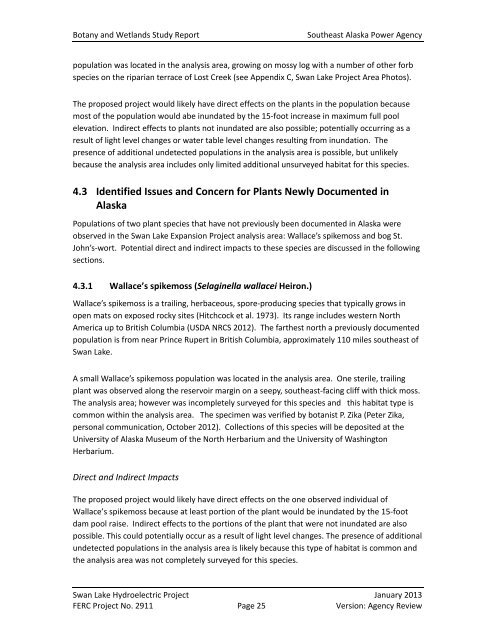Botany and Wetlands Study Report - McMillen, LLC
Botany and Wetlands Study Report - McMillen, LLC
Botany and Wetlands Study Report - McMillen, LLC
Create successful ePaper yourself
Turn your PDF publications into a flip-book with our unique Google optimized e-Paper software.
<strong>Botany</strong> <strong>and</strong> Wetl<strong>and</strong>s <strong>Study</strong> <strong>Report</strong>Southeast Alaska Power Agencypopulation was located in the analysis area, growing on mossy log with a number of other forbspecies on the riparian terrace of Lost Creek (see Appendix C, Swan Lake Project Area Photos).The proposed project would likely have direct effects on the plants in the population becausemost of the population would abe inundated by the 15‐foot increase in maximum full poolelevation. Indirect effects to plants not inundated are also possible; potentially occurring as aresult of light level changes or water table level changes resulting from inundation. Thepresence of additional undetected populations in the analysis area is possible, but unlikelybecause the analysis area includes only limited additional unsurveyed habitat for this species.4.3 Identified Issues <strong>and</strong> Concern for Plants Newly Documented inAlaskaPopulations of two plant species that have not previously been documented in Alaska wereobserved in the Swan Lake Expansion Project analysis area: Wallace’s spikemoss <strong>and</strong> bog St.John’s‐wort. Potential direct <strong>and</strong> indirect impacts to these species are discussed in the followingsections.4.3.1 Wallace’s spikemoss (Selaginella wallacei Heiron.)Wallace’s spikemoss is a trailing, herbaceous, spore‐producing species that typically grows inopen mats on exposed rocky sites (Hitchcock et al. 1973). Its range includes western NorthAmerica up to British Columbia (USDA NRCS 2012). The farthest north a previously documentedpopulation is from near Prince Rupert in British Columbia, approximately 110 miles southeast ofSwan Lake.A small Wallace’s spikemoss population was located in the analysis area. One sterile, trailingplant was observed along the reservoir margin on a seepy, southeast‐facing cliff with thick moss.The analysis area; however was incompletely surveyed for this species <strong>and</strong> this habitat type iscommon within the analysis area. The specimen was verified by botanist P. Zika (Peter Zika,personal communication, October 2012). Collections of this species will be deposited at theUniversity of Alaska Museum of the North Herbarium <strong>and</strong> the University of WashingtonHerbarium.Direct <strong>and</strong> Indirect ImpactsThe proposed project would likely have direct effects on the one observed individual ofWallace’s spikemoss because at least portion of the plant would be inundated by the 15‐footdam pool raise. Indirect effects to the portions of the plant that were not inundated are alsopossible. This could potentially occur as a result of light level changes. The presence of additionalundetected populations in the analysis area is likely because this type of habitat is common <strong>and</strong>the analysis area was not completely surveyed for this species.Swan Lake Hydroelectric Project January 2013FERC Project No. 2911 Page 25 Version: Agency Review


